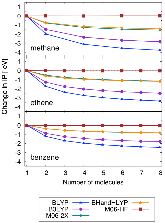|
Quantum Chemistry on Graphical Processing Units. 2. Direct Self-Consistent-Field Implementation
|
journal
|
March 2009 |
|
Excited-State Electronic Structure with Configuration Interaction Singles and Tamm–Dancoff Time-Dependent Density Functional Theory on Graphical Processing Units
|
journal
|
May 2011 |
|
Quantum Chemical Calculations Using Accelerators: Migrating Matrix Operations to the NVIDIA Kepler GPU and the Intel Xeon Phi
|
journal
|
February 2014 |
|
Computation of the Density Matrix in Electronic Structure Theory in Parallel on Multiple Graphics Processing Units
|
journal
|
November 2014 |
|
Relationship between long-range charge-transfer excitation energy error and integer discontinuity in Kohn–Sham theory
|
journal
|
December 2003 |
|
Fundamental gaps with approximate density functionals: The derivative discontinuity revealed from ensemble considerations
|
journal
|
May 2014 |
|
A self-interaction-free local hybrid functional: Accurate binding energies vis-à-vis accurate ionization potentials from Kohn-Sham eigenvalues
|
journal
|
May 2014 |
|
A challenge for density functionals: Self-interaction error increases for systems with a noninteger number of electrons
|
journal
|
August 1998 |
|
Many-electron self-interaction error in approximate density functionals
|
journal
|
November 2006 |
|
Insights into Current Limitations of Density Functional Theory
|
journal
|
August 2008 |
|
Structural manifestation of the delocalization error of density functional approximations: C4N+2 rings and C20 bowl, cage, and ring isomers
|
journal
|
June 2010 |
|
Delocalization error of density-functional approximations: A distinct manifestation in hydrogen molecular chains
|
journal
|
December 2012 |
|
Extreme density-driven delocalization error for a model solvated-electron system
|
journal
|
November 2013 |
|
Density-Functional Theory for Fractional Particle Number: Derivative Discontinuities of the Energy
|
journal
|
December 1982 |
|
Tests of functionals for systems with fractional electron number
|
journal
|
April 2007 |
|
Fractional charge perspective on the band gap in density-functional theory
|
journal
|
March 2008 |
|
Curvature and Frontier Orbital Energies in Density Functional Theory
|
journal
|
December 2012 |
|
Long-range charge-transfer excited states in time-dependent density functional theory require non-local exchange
|
journal
|
August 2003 |
|
A long-range-corrected time-dependent density functional theory
|
journal
|
May 2004 |
|
Kohn-Sham Self-Interaction Correction in Real Time
|
journal
|
April 2012 |
|
Generalized Kohn-Sham schemes and the band-gap problem
|
journal
|
February 1996 |
|
Coulomb-attenuated exchange energy density functionals
|
journal
|
July 1996 |
|
A long-range correction scheme for generalized-gradient-approximation exchange functionals
|
journal
|
August 2001 |
|
A new hybrid exchange–correlation functional using the Coulomb-attenuating method (CAM-B3LYP)
|
journal
|
July 2004 |
|
Long-range–short-range separation of the electron-electron interaction in density-functional theory
|
journal
|
December 2004 |
|
Density Functional Theory with Correct Long-Range Asymptotic Behavior
|
journal
|
February 2005 |
|
Systematic optimization of long-range corrected hybrid density functionals
|
journal
|
February 2008 |
|
Excitation Gaps of Finite-Sized Systems from Optimally Tuned Range-Separated Hybrid Functionals
|
journal
|
April 2012 |
|
Delocalization Error and “Functional Tuning” in Kohn–Sham Calculations of Molecular Properties
|
journal
|
June 2014 |
|
Organic Electronic Materials: Recent Advances in the DFT Description of the Ground and Excited States Using Tuned Range-Separated Hybrid Functionals
|
journal
|
April 2014 |
|
Prediction of charge-transfer excitations in coumarin-based dyes using a range-separated functional tuned from first principles
|
journal
|
December 2009 |
|
Reliable Prediction of Charge Transfer Excitations in Molecular Complexes Using Time-Dependent Density Functional Theory
|
journal
|
March 2009 |
|
Koopmans’ springs to life
|
journal
|
December 2009 |
|
Tuned Range-Separated Hybrids in Density Functional Theory
|
journal
|
March 2010 |
|
Charge-Transfer-Like π→π* Excitations in Time-Dependent Density Functional Theory: A Conundrum and Its Solution
|
journal
|
July 2011 |
|
Quasiparticle Spectra from a Nonempirical Optimally Tuned Range-Separated Hybrid Density Functional
|
journal
|
November 2012 |
|
Optimum Exchange for Calculation of Excitation Energies and Hyperpolarizabilities of Organic Electro-optic Chromophores
|
journal
|
August 2014 |
|
Improved Prediction of Properties of π-Conjugated Oligomers with Range-Separated Hybrid Density Functionals
|
journal
|
July 2011 |
|
Influence of the Delocalization Error and Applicability of Optimal Functional Tuning in Density Functional Calculations of Nonlinear Optical Properties of Organic Donor-Acceptor Chromophores
|
journal
|
June 2013 |
|
Density-functional errors in ionization potential with increasing system size
|
journal
|
May 2015 |
|
Tuned range separated hybrid functionals for solvated low bandgap oligomers
|
journal
|
July 2015 |
|
Counterintuitive electron localisation from density-functional theory with polarisable solvent models
|
journal
|
November 2015 |
|
Density-functional exchange-energy approximation with correct asymptotic behavior
|
journal
|
September 1988 |
|
Development of the Colle-Salvetti correlation-energy formula into a functional of the electron density
|
journal
|
January 1988 |
|
Density‐functional thermochemistry. III. The role of exact exchange
|
journal
|
April 1993 |
|
The M06 suite of density functionals for main group thermochemistry, thermochemical kinetics, noncovalent interactions, excited states, and transition elements: two new functionals and systematic testing of four M06-class functionals and 12 other functionals
|
journal
|
July 2007 |
|
Density Functional for Spectroscopy: No Long-Range Self-Interaction Error, Good Performance for Rydberg and Charge-Transfer States, and Better Performance on Average than B3LYP for Ground States
|
journal
|
December 2006 |
|
Comparison of simple potential functions for simulating liquid water
|
journal
|
July 1983 |
|
Hartree-Fock instabilities and electronic properties
|
journal
|
April 2000 |
|
Entanglement and Polyradical Character of Polycyclic Aromatic Hydrocarbons Predicted by Projected Hartree–Fock Theory
|
journal
|
May 2013 |







